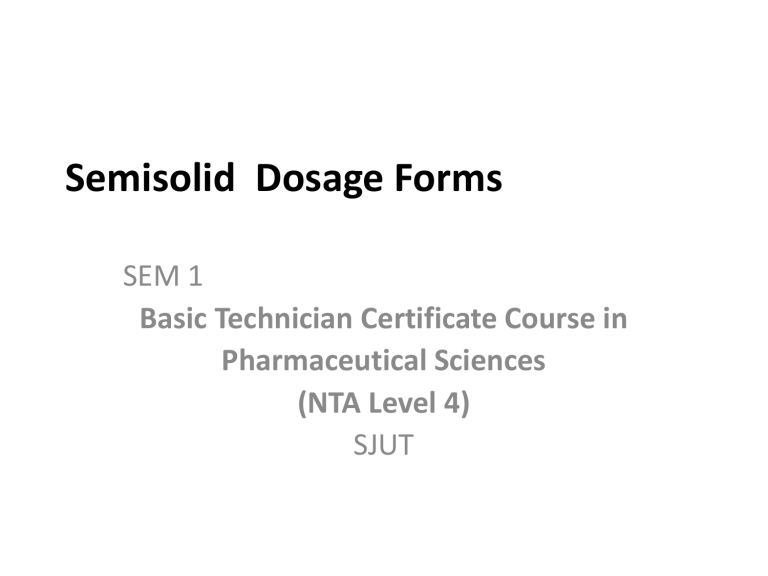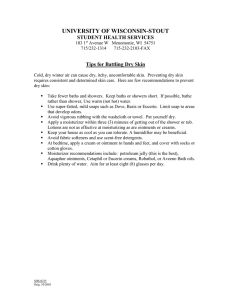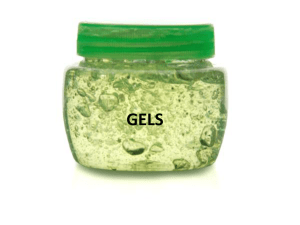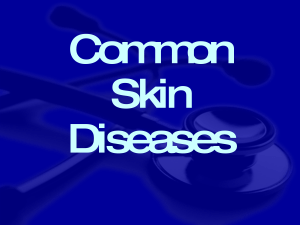
Semisolid Dosage Forms SEM 1 Basic Technician Certificate Course in Pharmaceutical Sciences (NTA Level 4) SJUT Students Learning Tasks • Describe semisolid dosage forms (creams, ointments, pastes, gels etc.) Definition: • Semisolid dosage forms are products of semisolid consistency and applied to skin or mucous membranes for therapeutic or protective action or cosmetic function. • They are intended for local drug delivery for treatment of conditions such as rashes, skin irritation, stings, infections (fungal, viral or bacterial). Properties of Semisolid Dosage Forms The ideal properties • Physical properties: – Smooth texture – Elegant (neat) in appearance – Non dehydrating – Non gritty – Non greasy and non-staining – Non hygroscopic • Physiological properties: – Non-irritating – Do not alter membrane / skin function – Miscible with skin secretion – Have low sensitization effect • Application properties: – Easily applicable with efficient drug release – High aqueous washability Types of Semisolid Dosage Forms • • • • • • Ointment Creams Pastes Gels Poultices Foams Ointments • Are homogenous, translucent, viscous semisolid preparations intended for application to the skin or mucous membranes. • Ointments are of greasy nature thus they stain clothes, are generally poor solvent for most drugs and usually decrease the drug delivery capabilities of the system • The main rule of the local therapy is that if the skin is dry, use an ointment OPHTHALMIC OINTMENTS • Ophthalmic ointments are meant for application to the eye. • They should be sterile and free from irritation. • They should be packed in sterile containers which should keep the preparation sterile until whole of it is used up. Creams • They are viscous semisolid emulsion system intended for application to the skin i.e. for external use. • Have opaque appearance compared with the translucent ointments. • Consistency and rheological characters depend on whether the cream is w/o or o/w. • Therefore, creams are of two types, aqueous creams and oily creams. • Oil-in-water creams are non-greasy and easy to rinse and therefore, more comfortable and cosmetically acceptable. • Properly designed water-in-oil creams are elegant drug delivery system, pleasing in both appearance and feel after application Pastes • Are semisolid preparations intended for external application containing a high proportion of finely powdered medicaments (about 50%) • Pastes are basically ointments into which a high percentage of finely powdered insoluble solid (such as starch, zinc oxide, calcium carbonate etc.) has been added. • The extraordinary amount of particulate matter stiffens the system. • Pastes are less penetrating than ointment. • Paste make particularly good protective barrier when placed on the skin for, in addition to forming an unbroken film, the solid they contain can absorb and thereby neutralize certain noxious chemicals before they ever reach the skin. • Like ointments, paste forms an unbroken relatively water impermeable film. • Unlike ointments, the film is opaque and therefore, an effective sun block accordingly. • Because of their stiffness and impenetrability, pastes are not suited for application to hairy parts of the body • They are often spread on a lint or gauze rather than being applied directly to the skin. Gels /Jellies • Gels are transparent or translucent non-greasy semisolid aqueous preparations meant for external application to the skin or mucous membrane. • Are prepared with the aid of a suitable gelling agents • Are often used when a non-greasy preparation is required for application to the scalp or skin • They are used for medication or lubrication purposes. • They are used for lubricating catheters, surgical gloves and rectal thermometers. • The gelling agents may be gelatin, or a carbohydrate such as gelatinized starch, tragacanth, sodium alginate or cellulose derivative. • E.g. contraceptive jellies (spermicidal action), ichthammol jelly, fastum (ketoprofen) gel, Vivian (diclofenac) gel etc. Poultices • It is thick, soft, viscous, paste-like preparation for external use. • Poultice must retain heat for a considerable time because they are intended to supply warmth to inflamed parts of body. • Poultices act by increasing blood flow, relaxing tense muscles, soothing inflamed tissues, or drawing toxins from an infected area. • Thus, they can be used to relieve the pain and inflammation associated with abscess; (e.g. Kaolin poultice B.P.C.) • HOW TO USE POLTICES ? • Extemporaneous poultice, for use, – the poultice is heated, with occasional stirring, until it can only just be tolerated on the back of the hand. – Then it is spread thickly on lint or other dressing and applied to the affected area which is sometimes first covered with muslin (very thin cloth) to facilitate removal after use. – A thick layer of cotton wool is applied to retain the heat and covering of oiled silk may be added to protect clothing. Foams • Foams are systems in which air or some other gas is emulsified in liquid phase to the point of stiffening. Example include shaving creams, whipped creams and aerosolized shaving creams • The extent and duration of diffusion depends on the physicochemical properties of the drug, the type of base and skin condition(s)




